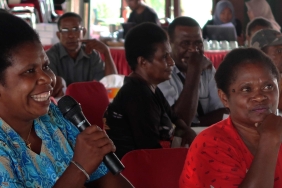TUNA FISHING AT NIGHT
Dwi Ariyogagautama or who is familiarly called Yoga has been working at WWF Solor Alor Project as Fisheries Officer for almost 3 years. Together with other WWF teams, he tries to develop responsible and sustainable fisheries, especially tuna fisheries. This Diponegoro University Marine Science graduate is active in the Marine Diving Club (MDC) scientific diving club.Profile...
By Dwi Ariyogagautama
The clock struck 20:30 WITA when we pushed our 2 GT boat off the beach in Watobuku (Lamakera) village. Armed with fishing rods, bait containers and kerosene gas lamps Pa Ahmad Muang and his son searched for live bait to catch tuna. After 20 minutes, Pa Ahmad started to turn on the gas lamp, the brighter the better to attract fish to approach the boat and make it easier for Pa Ahmad to fish. One by one, he got the tembang minyak (Temi) fish with a reel fishing rod, as soon as possible his catch was put into the bait collection basket to keep the temi alive.
The live bait began to fill the collection basket, we took a break to wait until 2:00 am, after which we rushed to the tuna fishing location in the Solor Strait waters. 20 minutes after arriving at the location, there were already 4 other fishing boats that started fishing at the location.
Using a longline with D1500 strings and a no. 4 hook wrapped around a 5ltr dirigible Pa Ahmad used the temi he had found as bait, 2 sets of fishing rods were thrown into the sea. Fishermen often call it drifting bait, without reducing the chances of getting fish Pa Ahmad still holds his own fishing rod. In less than 30 minutes the bait was snatched by the tuna. Unfortunately, the catch was a baby tuna, and this happened twice, with each yellowfin tuna weighing 15kg. Pa Ahmad found it very hard to let go of his catch, even though he understood that the tuna was not yet mature. Economic interests and the sustainability of tuna resources are still difficult for him to accept.
Until 04:30, 1 more yellowfin tuna was obtained, this time Pa Ahmad got a tuna with a mature size of 30kg. At the same time another fisherman was pulling the fishing line with difficulty, it had been 1 hour that the fisherman pulled the string of the new tuna seen on the surface of the sea. The fisherman got a yellowfin tuna with a size of ± 80 kg with a length of 170 cm. Without waiting any longer, the fisherman immediately walked to the collector (middleman) to be weighed immediately before the quality of the tuna decreased.
The sun had risen, we hurried back to the village, as well as other fishermen were already seen leaving the fishing location. Arriving at the beach, the women (papalele) had started to bargain the price of Pa Ahmad's and other fishermen's catches. 3 yellowfin tuna caught by Pa Ahmad were bought at a price of Rp.310,000, 30 kg of yellowfin were sold at a price of Rp.160,000, while 2 tails with a size of 15kg each were priced at Rp. 150,000. The system of buying papalele does not see the quality because they will resell it in the local market in the form of smaller pieces.
Unlike the case with fishermen who previously sold tuna to collectors, quality determines the price, 1 tuna obtained can be valued at Rp.1,200,000. The sustainability of tuna resources is believed to be realized if many fishermen think like these fishermen, namely prioritizing quality over quantity in their catch.





